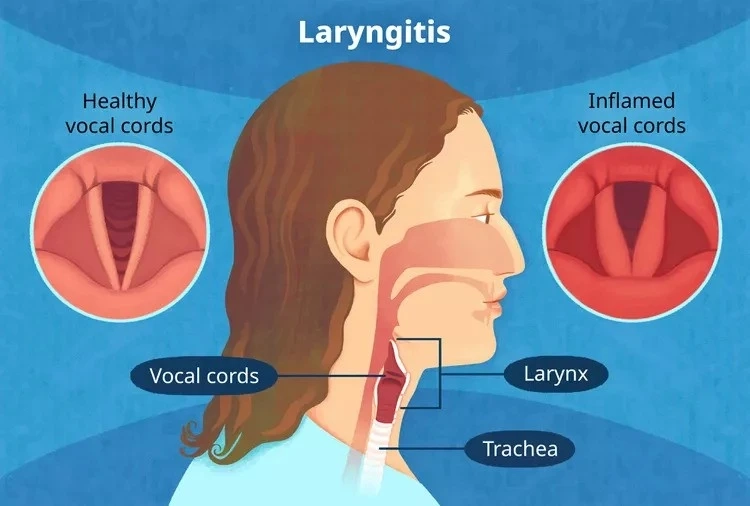The larynx, commonly known as the voice box, is a vital component of the human body responsible for voice production. It houses the vocal cords, two folds of mucous membrane crucial for creating an individual's unique voice. Additionally, the larynx acts as a gateway to the airway and trachea, playing a pivotal role in the respiratory system.
During normal functioning, the vocal cords open and close smoothly, forming sounds through their movement and vibration. These vocal cords also serve as a protective barrier for the airway and trachea, preventing foreign particles from entering the respiratory system.
WHAT IS LARYNGITIS
Laryngitis, a prevalent inflammatory clinical condition of the larynx, is colloquially referred to as an infection of the voice box. It commonly occurs due to overuse, irritation, or infection of the larynx. The primary cause of laryngitis is often viral, associated with upper respiratory tract infections, but it can also result from secondary infections like tonsillitis or chest infections.
During laryngitis, the vocal cords become inflamed, swollen, or irritated. This inflammation interferes with the normal movement and vibration of the vocal cords, leading to a distorted sound when air passes over them. The listener perceives this distortion as hoarseness in the individual's voice. In severe cases, laryngitis can cause temporary loss or near-undetectability of the voice.
There are two main types of laryngitis: acute and chronic. Acute laryngitis manifests with a sudden onset of hoarseness triggered by upper respiratory tract infections like acute rhinitis, pharyngitis, or tonsillitis. Hoarseness in acute laryngitis typically does not persist for more than a couple of weeks. On the other hand, chronic laryngitis is characterized by hoarseness lasting more than three weeks, often with an insidious onset and a reduction in pitch.
The symptoms of laryngitis vary between acute and chronic forms. Acute laryngitis symptoms include hoarseness of voice, husky or raspy voice, weak voice or voice loss, tickling sensation in the throat, discomfort, excess phlegm production, sore throat, dry throat, dry cough, and symptoms similar to the common cold. Chronic laryngitis presents with alterations in voice quality, rough or coarse voice, reduction in pitch, persistent hoarseness lasting for months or years, easily tired voice, painful or strained speaking, hawking sensation, discomfort in the throat, persistent dry cough, and other associated symptoms.
CAUSES OF LARYNGITIS
The causes of laryngitis can be broadly categorized into infectious and non-infectious causes. Infectious causes include viral, bacterial, and fungal infections. Common viruses responsible for laryngitis include rhinovirus, parainfluenza viruses, adenovirus, picornavirus, Coxsackie, ECHO viruses, and respiratory syncytial virus. Bacterial infections may involve Streptococcus pneumoniae, Haemophilus influenzae, and Moraxella catarrhalis. Fungal infections, known as mycotic laryngitis, can be secondary to fungus spores inhalation in immunosuppressed patients or those using inhaled steroid medications.
Non-infectious causes encompass vocal abuse, heavy smoking, rhinosinusitis, allergies, laryngopharyngeal reflux, trauma to the larynx, and chemical or thermal burns due to inhalation or ingestion of various substances. Risk factors for laryngitis include infections in paranasal sinuses, teeth, tonsils, and lungs, occupational exposure to dust and fumes, smoking, alcohol consumption, chronic coughing, vocal abuse, gastroesophageal reflux disease (GERD), and inadequate hydration.
DIAGNOSIS
Diagnosing laryngitis involves various techniques such as indirect laryngoscopy, laryngeal endoscopy, fiber-optic laryngoscopy, stroboscopy, and biopsy. These methods help visualize the vocal cords and surrounding structures, ensuring an accurate diagnosis. However, it's crucial to differentiate laryngitis from other conditions that mimic its symptoms, such as tuberculosis, leprosy, sarcoidosis, autoimmune disorders, acid reflux, cancer, and various vocal cord disorders.
Immediate medical attention is warranted if the patient experiences difficulty in breathing, no improvement or deterioration in hoarseness, coughing up blood, persisting fever, or persistent pain or difficulty in swallowing.
TREATMENT
Treatment strategies for laryngitis encompass both home remedies and medical interventions. Home remedies include voice rest, avoiding gargling, drinking plenty of fluids, and steam inhalation in moderation. Medications may include antibiotics for bacterial infections, antifungals for fungal infections, corticosteroids to reduce inflammation, cough suppressants, expectorants, mucolytics, proton-pump inhibitors for GERD, painkillers, decongestants, and voice therapy.
Additionally, lifestyle changes, such as avoiding smoking, alcohol, pollution, dust, fumes, and chemicals, are recommended. Decongestants are a subject of debate among clinicians, and voice therapy plays a crucial role in improving vocal cord usage.
CONCLUSION
In conclusion, understanding the various aspects of laryngitis, including its types, symptoms, causes, risk factors, diagnosis, and treatment options, is essential for effective management and recovery. Combining medical interventions with lifestyle modifications can significantly contribute to the successful resolution of laryngitis and the restoration of vocal health.


